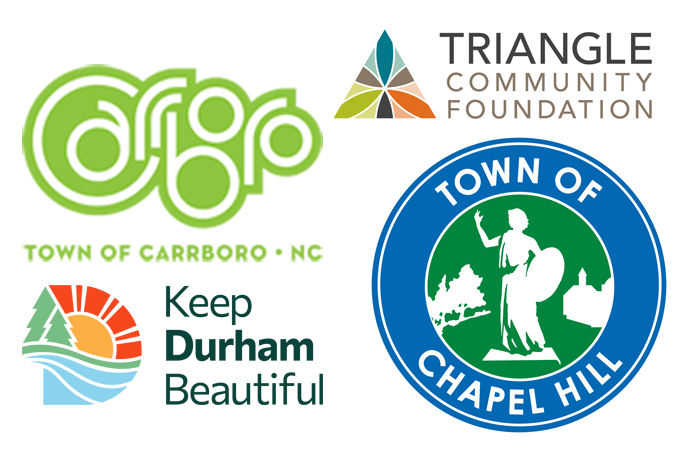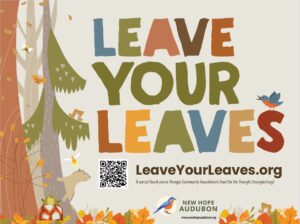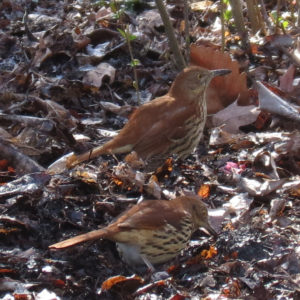Leave Your Leaves
Why You Should Leave your Leaves
Did you know that leaves are natures fertilizers and provide essential nutrients for the trees from which they fall! They also provide shelter for many insects during the winter months and are an essential part of an intact ecosystem supporting wildlife. If we don’t have leaves, most of our butterflies, moths, bees and insects won’t have the cover they need to reach maturity, and our birds and wildlife won’t have the food they need to survive. Leaf litter provides winter habitat for many pollinators and 94% of caterpillars—the two classes of insects we need most. Leaving your leaves also helps reduce flooding, air, water and noise pollution and saves you time and money.
If you would like to offer your time to make presentations to schools, garden clubs or other organizations to spread the word, let us know. Our Leave the Leaves presentation provides a background on how leaves benefit our ecosystem, support our insects, bees, birds and wildlife, improve tree and soil health and reduce flooding, erosion, air, water and noise pollution and save us time and money. We also have toolboxes designed for teachers and homeschoolers to use to encourage students to learn about the benefits of leaving the leaves. These toolboxes are loaded with fun, hands-on activities customized to grades K-12.
It’s Easy To Do!
Participation in this program is easy. Just skip your town’s loose-leaf collection and do one of the actions below—or some combination that works best for your situation. If you find you have too many leaves, strongly consider reducing your lawn area and increasing the mulched area under trees and in garden bed areas.
BEST: Leave your leaves where they fall. Effort level 0!
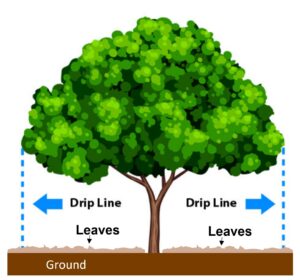
GOOD: In areas where that’s not an option, such as areas of grass you need to maintain, gently rake or blow leaves with an electric blower (best for environmental and noise pollution) into adjacent areas to use as mulch such as:
– under your trees in an even “carpet” extending out as far past the tree canopy dripline as possible.
– under your shrubs
-in your garden beds, which, hopefully, are filled with native plants
AS A LAST RESORT: Mulch leaves directly into your grass with a mulching lawnmower (preferably an electric one to prevent pollution). -OR- Use leaves in your compost pile or composter.
THE RIGHT WAY TO ADD LEAVES UNDER TREES
It’s important when adding leaves to those already under trees to mimic nature’s even carpet of fallen leaves and to have the leaf layer extend to at least the drip line of the canopy. Think of this as the outer edge of the leaf canopy as viewed from above. Additional dos and don’ts include:
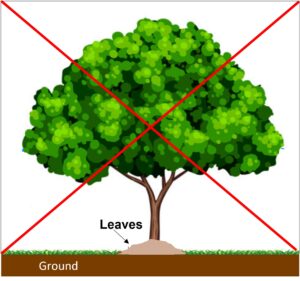
Don’t pile leaves around the base of the tree. Leave the tree flare at the base of the tree uncovered since it needs to be in the open air to prevent rot, disease, and insect and rodent damage in this important area. Tree flare or root flare is the bark covered trunk just above the soil line where the tree trunk flares out in the transition to tree roots. (Note: When planting new trees it is also critical to keep this part of the tree trunk above the soil line).
Rake leaves from adjacent areas to underneath the trees from which they’ve fallen whenever possible. Trees are best adapted to the acidity levels and micro-environment their own leaves create as they decompose.
Don’t make the leaf layer too thick so that it blocks water from reaching the ground underneath the tree.
View Our Webinar
Check out our Leave Your Leaves webinar hosted by New Hope Bird Alliance and Audubon North Carolina and presented by retired biology professor Karen Stine as part of NC Native Plants Week. Here’s the link.
Take the Pledge to Leave your Leaves
Demonstrate your support for climate resilience and biodiversity by pledging to leave your leaves. Chapel Hill, Carrboro, and Durham residents can receive a yard sign! Chapel Hill and Carrboro residents can complete the pledge here, and Durham residents can complete the pledge here. Learn more about the Leave Your Leaves program on the Town of Chapel Hill and Keep Durham Beautiful websites.
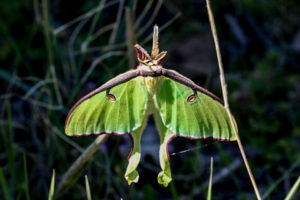
Luna moth cocoons overwinter in leaf litter, emerging as adults in the spring. Photo by Barbara Driscoll
Help Spread the Word
If you would like to offer your time to make presentations to schools, garden clubs or other organizations to spread the word, let us know. Our Leave the Leaves presentation provides a background on how leaves benefit our ecosystem, support our insects, bees, birds and wildlife, improve tree and soil health and reduce flooding, erosion, air, water and noise pollution and save us time and money.
Links to Resources
- Leave Your Leaves Brochure
- Leave Your Leaves Poster
- Yard Sign
- Leave Your Leaves Presentations
- Educational toolboxes for teachers
For questions or ways to get involved with this project, send email with the subject line “Leave Your Leaves” to [email protected].
We were awarded a Sustainable Communities grant from the Triangle Community Foundation in the amount of $15,000 to create and pilot a “Leave Your Leaves” public education program enhancing environmental conservation efforts in our local communities.
